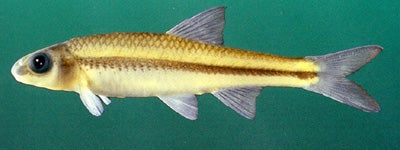MIMIC SHINER
SCIENTIFIC NAME: Notropis volucellus
CHARACTERISTICS: Notropis volucellus is a slender species with a compressed body and a broad, rounded snout extending slightly beyond the mouth. At the front of the narrow lateral line, the pores look as though they have been stitched together by dark melanophores above and below each pore. On the peduncle, the lateral line is well developed, expanding ventrally into a lobed tail spot extending onto the caudal fin rays. The distinct predorsal stripe is heavily pigmented. Scales on the back are well outlined with pigment, and the caudal peduncle scales are more heavily pigmented posteriorly than anteriorly. Breeding colors do not develop. The mimic shiner is morphologically variable throughout its range. In the Tennessee River drainage, it occurs sympatrically with the channel shiner, N. wickliffi, which is distinguished by an indistinct predorsal stripe and uniformly pigmented caudal peduncle scales. An undescribed Mobile basin form of N. volucellus differs from the form described in this account by having different body proportions and an interrupted sensory canal under the eye (Mayden and Kuhajda, 1989). The Mobile basin form is pictured above. See Cope (1865b) for original description.
ADULT SIZE: 1.6 to 3 in (40 to 75 mm)
DISTRIBUTION: Notropis volucellus as currently recognized is found throughout Gulf slope drainages from the Guadalupe River east to the Mobile basin and north to the Red River of North in Canada. The undescribed “Mobile mimic shiner” is sympatric with N. cahabae in the Cahaba River (Mayden and Kuhajda, 1989).
HABITAT AND BIOLOGY: Schools of mimic shiners are most frequently encountered around concentrations of river weed over sand or sand and gravel substrates in large rivers and streams. The spawning season extends from May to August throughout Alabama, and females running with eggs occur from late April to July in the Cahaba River. Etnier and Starnes (1993), relying on their observations of breeding tubercle development, indicate an extended spawning season – from May through October – for Tennessee populations. Moyle (1973) reports that the diet of mimic shiners inhabiting a Minnesota lake consists of dipteran pupae, detritus, crustaceans, mayflies, and beetles.
ORIGINAL DESCRIPTION: Cope described the mimic shiner in 1865.
ETYMOLOGY:
Notropis means keeled back.
Volucellus means winged or swift.
The copyrighted information above is from Fishes of Alabama and the Mobile Basin.






